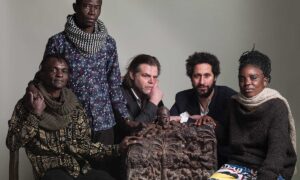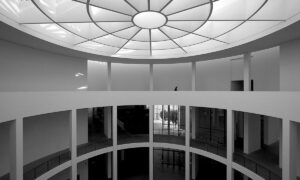
The Bienal de São Paulo, the main art biennial in South America, was founded in 1951 by the Brazilian industrialist Ciccillo Matarazzo as Brazil experienced a brief period of robust economic and cultural development, following the founding of the Museu de Arte de São Paulo Assis Chateaubriand (Masp), the first modern art museum in the country, in 1947. Each subsequent edition of the biennial has been marked by the complex social and political transformations of Brazil, and its current iteration opened earlier this month as the Brazilian cultural sector experiences a renaissance under the administration of president Luiz Inácio Lula da Silva—and recuperates from the effects of the pandemic and the former Jair Bolsonaro administration.This 35th edition of the biennial, Coreografias do Impossível (Choreographies of the Impossible) (until 10 December), takes dance as a departure point to address decolonisation, environmentalism and resistance against oppressive political frameworks. It is the biennial’s most diverse edition to date, with a predominant focus on artists from the so-called “Global South”, including more than 1,000 works by 121 artists, of whom more than 80% are non-white. The curatorial cohort responsible for the exhibition includes the Brazilian curator Diane Lima, the Portuguese artist and writer Grada Kilomba, the Brazilian curator and anthropologist Hélio Menezes and the Spanish artist and curator Manuel Borja-Villel, who is the former director of the Museo Nacional Centro de Arte Reina Sofía.“Our goal was to create an edition free from categories and limiting structures, looking beyond geographical and geopolitical notions, freeing ourselves from labels attached to people [and] transcending categories and rigid frameworks for understanding people’s backgrounds,” the curators told The Art Newspaper in a joint statement. “We embraced a decentralised system, consciously choosing not to have a chief curator and thus dissolving hierarchical structures and promoting equal contributions from all members. We also incorporated this fluidity into our artist selection process, seeking an unparalleled multiplicity of participants.”Installation view of Mimenekenu É Lá Tempo (2023) by Ana Pi and Taata Kwa Nkisi Mutá Imé in the 35th Bienal de São Paulo, Choreographies of the Impossible © Levi Fanan / Fundação Bienal de São PauloThe curators add, “The diversity [of the biennial and the curatorial team] emerged naturally—not as a deliberate effort, but as a reflection of the multifaceted nature of our contemporary artistic landscape. Our focus extends beyond individual nationalities, recognising that the concept of nationality itself can be a product of colonial and outdated categorisations.”The exhibition opens with several site-specific commissions, including the kinetic installation Mimenekenu É Lá Tempo (2023) by the French Brazilian artist Ana Pi and Taata Kwa Nkisi Mutá Imé, a high priest of the Candomblé religion. Comprising a series of oscillating poles, video installations of nebulous clouds and ceramic footprints, the work evokes the ritual dance of a Candomblé orixá or deity associated with the air and wind currents. Like this piece, some of the strongest presentations in the show, albeit potentially esoteric to foreign audiences, consider the entanglement of Africa and Brazil through the lens of Candomblé and other African diasporic religions that formed in Brazil as enslaved Africans—most of them of Yoruba, Bantu and Gbe origin—began syncretising their beliefs with those of the region’s predominantly Catholic Portuguese colonists in the 16th century.Candomblé has been widely practiced in Brazil since the 19th century but was only officially legalised in 1976, and its practitioners have long faced persecution and violence. A series of 16mm films by the late American dancer and anthropologist Katherine Dunham like Xangó (1947) and Lavadeira (Washerwoman) (1956) capture Candomblé ceremonies in the decades when the practice was prohibited, showing initiates from various racial backgrounds performing ritualistic dances. These and several other works consider the intercultural complexities of the African diaspora in the country.The Brazilian artist Daniel Lie fuses visual elements of a Candomblé spiritual centre with those found in Buddhist, Catholic and Umbanda ritual spaces in Outres (2023), an installation made up of organic materials like mushroom spores that will sprout during the run of the exhibition, along with textiles that are woven through the columns of the Bienal Pavilion. (The work is a monumental expansion of the artist’s 2022 installation, Unnamed Entities, at the New Museum in New York.) Elsewhere in the exhibition, videos by the Brazilian artist Luiz de Abreu like Black Fashion (2006) and Samba do Crioulo Doido (2004) critique the myth of racial democracy in Brazil, depicting primarily nude dance performances intended to symbolise stereotypical and racist expectations of Black Brazilians’ artistic repertoire.Still from Yuri u xëatima thë – A Pesca com Timbó (Fishing with Timbó) (2023), directed by Aida Harika Yanomami, Edmar Tokorino Yanomami and Roseane Yariana Yanomami Photo: Roseane Yariana YanomamiSeveral other works in the biennial explore movement in the spiritual and natural worlds from Indigenous perspectives, reflecting on the state of the Amazon as the Lula administration makes significant efforts to combat deforestation, illegal mining and encroachment on Indigenous lands. Days before the exhibition opened, the federal government announced it had destroyed more than 300 mining rafts in its largest such operation to date in the state of Amazonas, which is home to Indigenous groups like the Yanomami, who have been decimated by disease and displacement since gold was discovered in their lands in the 1940s.Aida Harika Yanomami’s film Thuë pihi kuuwi (Uma Mulher Pensando) (A Woman Thinking) (2023) is a poetic documentation of the Yanomami tribe. It observes the preparation of the hallucinogenic snuff yäkoana and other cultural traditions that have survived since the Yanomami’s first contact with religious missionaries in the 1910s. A series of sketchbooks by the late Indigenous author Gabriel dos Santos Gentil, a Tukano shaman and activist, similarly considers the preservation of ancestral knowledge from the Amazon, including compelling drawings and texts documenting Tukano cosmology.Installation view of works by Sonia Gomes in the 35th Bienal de São Paulo, Choreographies of the Impossible © Levi Fanan / Fundação Bienal de São PauloOther works explore the theme through a more abstract approach, like a series of works by the Brazilian artist Sonia Gomes, who intertwines found or gifted textiles into lyrical sculptures that are inspired by the dynamism of Brazilian dance. Another centrepiece of the exhibition is the late Brazilian artist Rubem Valentim’s Templo de Oxála (Oxalá Temple) (1977)—an installation comprised of 20 white sculptures, most that are being shown together again for the first time since the 1977 Bienal de São Paulo—that evokes liturgical Afro Brazilian forms through rhythmic geometric contours.Organisers predict the current edition of the biennial will receive more than one million visitors, which would be a boost from the approximately 750,000 visitors to the last edition. They expect the biennial will also have a record number of foreign visitors, as Brazil continues to reaffirm global connections and its presence in the international art market. “We can feel that things are moving forward in the arts and cultural scene, which we are delighted to see,” the biennial’s curators said. “Although there is a long way to go, we feel carried by this wave of change. We hope that this biennial will spread awareness for Brazil’s distinctly rich historical and cultural heritage.”The Bienal de São Paulo is the second longest-running biennial in the world after the Venice Biennale, which next year will be curated by Adriano Pedrosa, the first Latin American curator to ever take the helm. Pedrosa, the chief curator of Masp, was also part of the Bienal de São Paulo’s curatorial team in 2006 and was an adjunct curator of the 1998 edition, Núcleo Histórico: Antropofagia e Histórias de Canibalismo (Historical Core: Anthropophagy and Stories of Cannibalism), organised by Paulo Herkenhoff—a landmark exhibition in Brazilian art history that explored the “antropofagia” movement of the 1920s, in which Brazilian artists sought to develop a uniquely Brazilian expression removed from direct Eurocentric influences.Installation view of Rubem Valentim’s Templo de Oxála (Oxalá Temple) (1977) at the 35th Bienal de São Paulo, Choreographies of the Impossible © Levi Fanan / Fundação Bienal de São Paulo35th Bienal de São Paulo, until 10 December, Ciccillo Matarazzo Pavilion, São Paulo
























